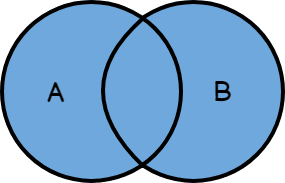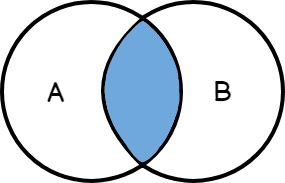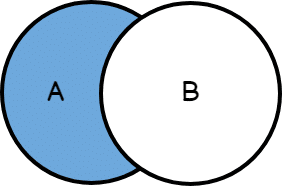Relational databases store information in table cells — in columns that describe aspects of an item and rows which tie together the columns. Combining the result sets from one or more SQL Select statements is done with the SQL set operators: UNION, UNION ALL, INTERSECT, and EXCEPT. The basic syntax of these set operators is:
SELECT column(s) FROM table1 set_operation SELECT column(s) FROM table2;
Each SELECT statement must have
- The same number of columns selected
- The same order of column specified
- The same data types between columns included (but not the same length)
Here we explore the meaning and use of the SQL set operators.
The SQL UNION Operation

The Venn diagram above a graphical representation of the overlap between two result sets “A”’ and “B”. The blue areas show the distinct portion of the sets; the white area shows the duplicates between them.
To illustrate the concept of a union between sets, consider tables of proper names and species, one of animals and a second of common housepets. (The complete SQL code for creating these tables appears at the bottom of this blog entry.)
The following SQL statement returns the UNION of these two tables:
SELECT name FROM animals UNION SELECT name FROM pets ;
| name |
| cat |
| dog |
| African bush elephant |
| panther |
| Egyptian vulture |
| ferret |
| leaf-nosed moray eel |
| lop-eared rabbit |
The SQL UNION ALL Operation

The SQL Union All set operator returns those results common to one or more SQL Select statements, including any duplicates.
SELECT name FROM animals UNION ALL SELECT name FROM pets ;
Note that “cat” and “dog” appear twice in the UNION ALL:
| name |
| cat |
| dog |
| African bush elephant |
| panther |
| Egyptian vulture |
| ferret |
| cat |
| dog |
| leaf-nosed moray eel |
| lop-eared rabbit |
The SQL INTERSECT Operation

The SQL Intersect set operator returns those rows which appear in the results of both SQL Select statements.
The syntax of SQL Intersect
SELECT name FROM animals
INTERSECT
SELECT name FROM pets ;
MySQL doesn’t provide a SQL Intersect operation. Implement your own:
SELECT animals.name FROM animals
WHERE animals.name
IN (
SELECT pets.name FROM pets) ;
| name |
| cat |
| dog |
The SQL EXCEPT Operation

The SQL Except set operator returns rows from the first SELECT statement that are not included in the results of the second SELECT statement.
SELECT name FROM animals WHERE name NOT IN (SELECT name FROM pets);
| name |
| African bush elephant |
| panther |
| Egyptian vulture |
Please note that in SQL Except the order of the arguments matter. Compare what follows with the above, where the animals and pets tables are reversed:
SELECT name FROM pets WHERE name NOT IN (SELECT name FROM animals);
| name |
| ferret |
| leaf-nosed moray eel |
| lop-eared rabbit |
Chaining SQL Set Operators
The above examples demonstrate the SQL set operators working on two SQL Select statements. This is the most common use case. Any number of SQL Select statements can be chained by extending the chain with the demonstrated syntax, like:
SELECT column(s) FROM table1 set_operation SELECT column(s) FROM table2; set_operation SELECT column(s) FROM table3; set_operation SELECT column(s) FROM table4;
(Actually, the SQL Selects don’t actually need to be against separate tables; they could all be referencing the same table.)
Conclusion
We’ve covered the syntax and use cases surrounding the ways to combine the result sets from one or more SQL Select statements via the SQL set operators: UNION, UNION ALL, INTERSECT, and EXCEPT. Where a particular database doesn’t natively support a set operator some SQL equivalencies are shown.
To learn more about SQL, check out other SQL blog posts and enroll in our SQL Nanodegree program.
SQL Sample Table Code
The following will build and populate the sample data referred to in this blog post. Test SQL interactively at SQL Fiddle or ExtendsClass.
CREATE TABLE animals ( name VARCHAR(99), species VARCHAR(99)) ; INSERT INTO animals VALUES ( 'cat', 'Felis catus' ), ( 'dog', 'Canis lupus familiaris' ), ( 'African bush elephant', 'Loxodonta africana' ), ( 'panther', 'Panthera pardus' ), ( 'Egyptian vulture', 'Neophron percnopterus' ) ; CREATE TABLE pets ( name VARCHAR(99), species VARCHAR(99)) ; INSERT INTO pets VALUES ( 'cat', 'Felis catus' ), ( 'dog', 'Canis lupus familiaris' ), ( 'ferret', 'Mustela putorius furo' ), ( 'leaf-nosed moray eel', 'Rhinomuraena quaesita' ), ( 'lop-eared rabbit', 'Oryctolagus cuniculus' ) ;
This article was originally going to use two tables, one of the symbols and English names of the chemical elements and another of the U. S. postal service abbreviations of the states and their full names, but that turned out to be non-intuitive and unwieldy. I leave them here should they become helpful.
CREATE TABLE elements ( symbol VARCHAR(2), name VARCHAR(33)) ; INSERT INTO elements VALUES ( 'Ac', 'Actinium' ), ( 'Ag', 'Silver' ), ( 'Al', 'Aluminum' ), ( 'Am', 'Americium' ), ( 'Ar', 'Argon' ), ( 'As', 'Arsenic' ), ( 'At', 'Astatine' ), ( 'Au', 'Gold' ), ( 'B', 'Boron' ), ( 'Ba', 'Barium' ), ( 'Be', 'Beryllium' ), ( 'Bh', 'Bohrium' ), ( 'Bi', 'Bismuth' ), ( 'Bk', 'Berkelium' ), ( 'Br', 'Bromine' ), ( 'C', 'Carbon' ), ( 'Ca', 'Calcium' ), ( 'Cd', 'Cadmium' ), ( 'Ce', 'Cerium' ), ( 'Cf', 'Californium' ), ( 'Cl', 'Chlorine' ), ( 'Cm', 'Curium' ), ( 'Cn', 'Copernicium' ), ( 'Co', 'Cobalt' ), ( 'Cr', 'Chromium' ), ( 'Cs', 'Cesium' ), ( 'Cu', 'Copper' ), ( 'Db', 'Dubnium' ), ( 'Ds', 'Darmstadtium' ), ( 'Dy', 'Dysprosium' ), ( 'Er', 'Erbium' ), ( 'Es', 'Einsteinium' ), ( 'Eu', 'Europium' ), ( 'F', 'Fluorine' ), ( 'Fe', 'Iron' ), ( 'Fl', 'Flerovium' ), ( 'Fm', 'Fermium' ), ( 'Fr', 'Francium' ), ( 'Ga', 'Gallium' ), ( 'Gd', 'Gadolinium' ), ( 'Ge', 'Germanium' ), ( 'H', 'Hydrogen' ), ( 'He', 'Helium' ), ( 'Hf', 'Hafnium' ), ( 'Hg', 'Mercury' ), ( 'Ho', 'Holmium' ), ( 'Hs', 'Hassium' ), ( 'I', 'Iodine' ), ( 'In', 'Indium' ), ( 'Ir', 'Iridium' ), ( 'K', 'Potassium' ), ( 'Kr', 'Krypton' ), ( 'La', 'Lanthanum' ), ( 'Li', 'Lithium' ), ( 'Lr', 'Lawrencium' ), ( 'Lu', 'Lutetium' ), ( 'Lv', 'Livermorium' ), ( 'Mc', 'Moscovium' ), ( 'Md', 'Mendelevium' ), ( 'Mg', 'Magnesium' ), ( 'Mn', 'Manganese' ), ( 'Mo', 'Molybdenum' ), ( 'Mt', 'Meitnerium' ), ( 'N', 'Nitrogen' ), ( 'Na', 'Sodium' ), ( 'Nb', 'Niobium' ), ( 'Nd', 'Neodymium' ), ( 'Ne', 'Neon' ), ( 'Nh', 'Nihonium' ), ( 'Ni', 'Nickel' ), ( 'No', 'Nobelium' ), ( 'Np', 'Neptunium' ), ( 'O', 'Oxygen' ), ( 'Og', 'Oganesson' ), ( 'Os', 'Osmium' ), ( 'P', 'Phosphorus' ), ( 'Pa', 'Protactinium' ), ( 'Pb', 'Lead' ), ( 'Pd', 'Palladium' ), ( 'Pm', 'Promethium' ), ( 'Po', 'Polonium' ), ( 'Pr', 'Praseodymium' ), ( 'Pt', 'Platinum' ), ( 'Pu', 'Plutonium' ), ( 'Ra', 'Radium' ), ( 'Rb', 'Rubidium' ), ( 'Re', 'Rhenium' ), ( 'Rf', 'Rutherfordium' ), ( 'Rg', 'Roentgenium' ), ( 'Rh', 'Rhodium' ), ( 'Rn', 'Radon' ), ( 'Ru', 'Ruthenium' ), ( 'S', 'Sulfur' ), ( 'Sb', 'Antimony' ), ( 'Sc', 'Scandium' ), ( 'Se', 'Selenium' ), ( 'Sg', 'Seaborgium' ), ( 'Si', 'Silicon' ), ( 'Sm', 'Samarium' ), ( 'Sn', 'Tin' ), ( 'Sr', 'Strontium' ), ( 'Ta', 'Tantalum' ), ( 'Tb', 'Terbium' ), ( 'Tc', 'Technetium' ), ( 'Te', 'Tellurium' ), ( 'Th', 'Thorium' ), ( 'Ti', 'Titanium' ), ( 'Tl', 'Thallium' ), ( 'Tm', 'Thulium' ), ( 'Ts', 'Tennnessine' ), ( 'U', 'Uranium' ), ( 'V', 'Vanadium' ), ( 'W', 'Tungsten' ), ( 'Xe', 'Xenon' ), ( 'Y', 'Yttrium' ), ( 'Yb', 'Ytterbium' ), ( 'Zn', 'Zinc' ), ( 'Zr', 'Zirconium' ) ; CREATE TABLE states ( symbol VARCHAR(2), name VARCHAR(33)) ; INSERT INTO states VALUES ( 'AL', 'Alabama' ), ( 'AK', 'Alaska' ), ( 'AZ', 'Arizona' ), ( 'AR', 'Arkansas' ), ( 'CA', 'California' ), ( 'CO', 'Colorado' ), ( 'CT', 'Connecticut' ), ( 'DE', 'Delaware' ), ( 'DC', 'District of Columbia' ), ( 'FL', 'Florida' ), ( 'GA', 'Georgia' ), ( 'HI', 'Hawaii' ), ( 'ID', 'Idaho' ), ( 'IL', 'Illinois' ), ( 'IN', 'Indiana' ), ( 'IA', 'Iowa' ), ( 'KS', 'Kansas' ), ( 'KY', 'Kentucky' ), ( 'LA', 'Louisiana' ), ( 'ME', 'Maine' ), ( 'MD', 'Maryland' ), ( 'MA', 'Massachusetts' ), ( 'MI', 'Michigan' ), ( 'MN', 'Minnesota' ), ( 'MS', 'Mississippi' ), ( 'MO', 'Missouri' ), ( 'MT', 'Montana' ), ( 'NE', 'Nebraska' ), ( 'NV', 'Nevada' ), ( 'NH', 'New Hampshire' ), ( 'NJ', 'New Jersey' ), ( 'NM', 'New Mexico' ), ( 'NY', 'New York' ), ( 'NC', 'North Carolina' ), ( 'ND', 'North Dakota' ), ( 'OH', 'Ohio' ), ( 'OK', 'Oklahoma' ), ( 'OR', 'Oregon' ), ( 'PA', 'Pennsylvania' ), ( 'RI', 'Rhode Island' ), ( 'SC', 'South Carolina' ), ( 'SD', 'South Dakota' ), ( 'TN', 'Tennessee' ), ( 'TX', 'Texas' ), ( 'UT', 'Utah' ), ( 'VT', 'Vermont' ), ( 'VA', 'Virginia' ), ( 'WA', 'Washington' ), ( 'WV', 'West Virginia' ), ( 'WI', 'Wisconsin' ), ( 'WY', 'Wyoming' ) ;
And not once was mentioned John Venn’s 1880 paper On the Diagrammatic and Mechanical Representation of Propositions and Reasonings.


